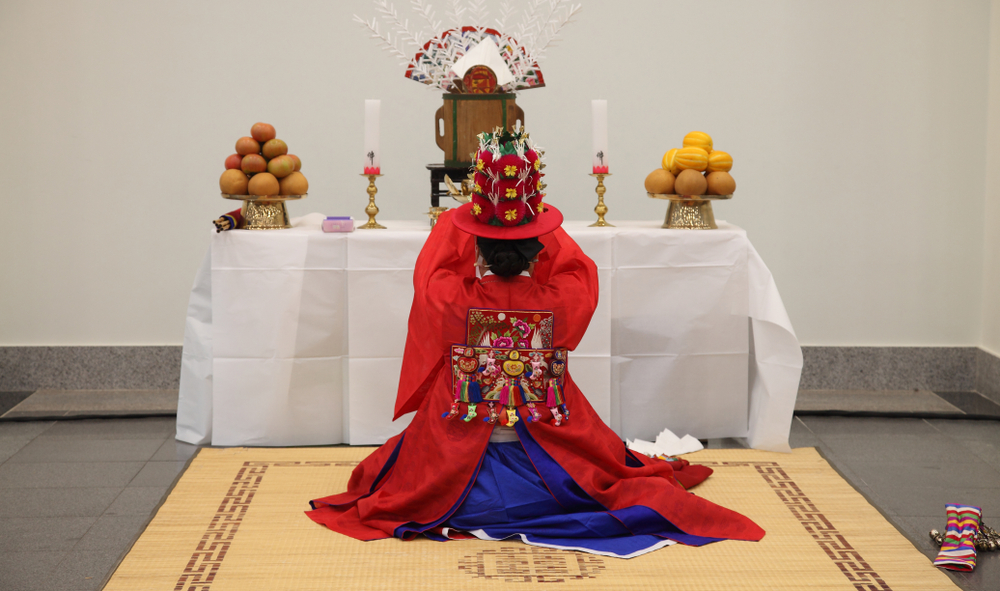
South Korea is a country of contrasts. It is a global leader in technology, fashion, and culture. Yet ancient traditions and modern sensibilities comfortably coexist. Shamans are a common sight, especially in metro areas like Seoul. But in a nation where Buddhism and Christianity claim more followers than folk religion, how can this be? Korean shamanism has fascinating roots, plus continued relevance to many Koreans today.
The Origins and Basics of Korean Shamanism
Buddhism, Confucianism, and Christianity each came to the Korean Peninsula. But shamanism has remained throughout its long history. It was first practiced in prehistoric times, well before the Gojoseon kingdom existed. Like most folk religions, it had no official doctrines or sacred texts. No religious body appointed shamans. For most, their authority came from the people who trusted them. And while there were no formal temples, some shrines did exist.
World History Encyclopedia explains that Korean shamanism sees existence in two worlds–the spirit and the living. The spirit world contains both good and evil entities that can influence human lives. Rocks, mountains, trees, and rivers have their own spirits. Geomancy is also a key belief–each area has its own resident spirits and life forces. These forces must be considered when placing temples, houses, and gravesites.
Mudang and Paksu: The Shaman’s Calling
Most Korean folk traditions allowed people of any gender to become shamans. Yet there were more female shamans in ancient times. That’s because it was one of the few vocations open to women. These “mudang,” along with their male counterparts called “paksu,” were often self-appointed. They usually took up the shaman’s mantle after having a divine experience. These experiences generally occurred during severe illnesses. Daughters of mudang often became shamans themselves.
Shamans can contact spirits or enter their world. Many acted as mediums when a family suspected that spirits were causing trouble. These ancestral spirits, also called “chosang,” could wreak serious havoc. A shaman’s goal was to determine what they wanted and convince them to leave the family alone. People also asked them for healing or benefits such as fertility and long life.
For some practices, mudang and paksu must enter an altered state of consciousness. They accomplish this through a ritual called “kut,” in which a spirit inhabits the shaman’s body for a short time. The spirit can then speak directly with other people. Artist Jorge Mañes Rubio witnessed this in action during a visit to Seoul. “The shaman becomes a god herself,” Rubio said in a TED Fellows piece. “[She] talks and moves differently, she presents completely different personalities–sometimes speaking in regional dialects that the shaman herself does not know . . . and assumes a position of authority.”
Korean Shamanism in the 21st Century
Today, Korean shamanism goes by many names–Muism, Shinism, and Shindo, to name a few. Traditions differ between north and south. The Han River, which runs through Seoul, is an unofficial dividing line of sorts. Shamans north of the river usually assume their calling after a serious illness, as was done in ancient times. For southern shamans, it is a hereditary vocation. And like centuries ago, most are women–around 90%, as estimated by Rubio after his visit to Seoul. With patriarchy still influencing the culture, shamanism offers women a meaningful spiritual path.
NPR mentions that public opinion about shamanism is split. Some South Koreans consider it an important part of their cultural heritage. Others view it as backward and probably best left in the past. Either way, shamans are here to stay. They perform fortune-telling, cleanse buildings, and take on serious personal problems. People often trust them to intercede for them, contact spirits, and make their lives better.

